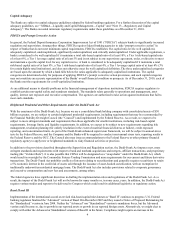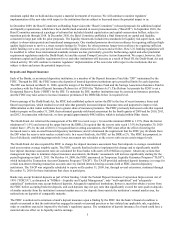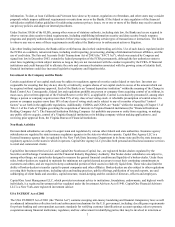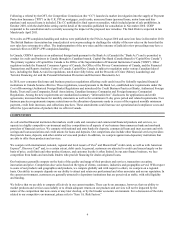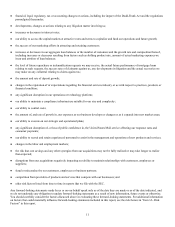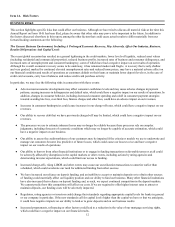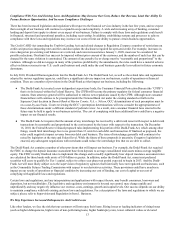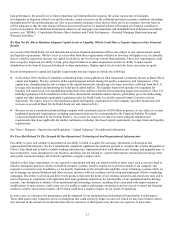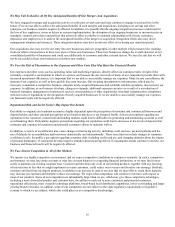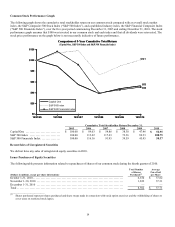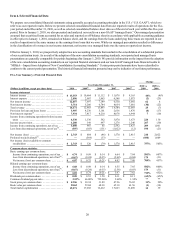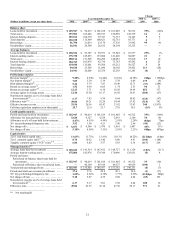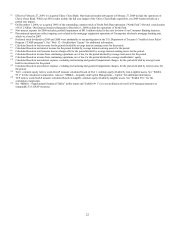Capital One 2010 Annual Report Download - page 33
Download and view the complete annual report
Please find page 33 of the 2010 Capital One annual report below. You can navigate through the pages in the report by either clicking on the pages listed below, or by using the keyword search tool below to find specific information within the annual report.13
Compliance With New And Existing Laws And Regulations May Increase Our Costs, Reduce Our Revenue, Limit Our Ability To
Pursue Business Opportunities, And Increase Compliance Challenges
There has been increased legislation and regulation with respect to the financial services industry in the last few years, and we expect
that oversight of our business will continue to expand in scope and complexity. A wide and increasing array of banking, consumer
lending and deposit laws apply to almost every aspect of our business. Failure to comply with these laws and regulations could result
in financial, structural and operational penalties, including receivership. In addition, establishing systems and processes to achieve
compliance with these laws and regulations may increase our costs or limit our ability to pursue certain business opportunities.
The Credit CARD Act (amending the Truth-in-Lending Act) and related changes to Regulation Z impose a number of restrictions on
credit card practices impacting rates and fees and also update the disclosures required for open-end credit. For example, increases in
rates charged on pre-existing card balances are restricted, and rates increased since January 1, 2009, must now be considered for
possible reductions. Overlimit fees may not be imposed without prior consent of the customer, and the number of such fees that can be
charged for the same violation is constrained. The amount of any penalty fee or charge must be “reasonable and proportional” to the
violation. Although we did not engage in many of the practices prohibited by the amendments, the rules could have a material adverse
effect on future revenues in our U.S. credit card business and could make the card business generally less resilient in future economic
downturns.
In July 2010, President Obama signed into law the Dodd-Frank Act. The Dodd-Frank Act, as well as the related rules and regulations
adopted by various regulatory agencies, could have a significant adverse impact on our business, results of operations or financial
condition. There are a number of provisions in the Dodd-Frank act that impact our business, including the following:
● The Dodd-Frank Act created a new independent supervisory body, the Consumer Financial Protection Bureau (the “CFPB”)
that is to be housed within the Federal Reserve. The CFPB will become the primary regulator for federal consumer financial
statutes. State attorneys general will be authorized to enforce new regulations issued by the CFPB. Although state consumer
financial laws will continue to be preempted under the National Bank Act under the existing standard set forth in the
Supreme Court decision in Barnett Bank of Marion County, N.A. v. Nelson, OCC determinations of such preemption must be
on a case-by-case basis. Courts reviewing the OCC’s preemption determinations will now consider the appropriateness of
those determinations under a different standard of judicial review. As a result, state consumer financial laws enacted in the
future may be held to apply to our business activities. The cost of complying with these additional laws could have a negative
impact on our financial results.
● The Dodd-Frank Act requires that the amount of any interchange fee received by a debit card issuer with respect to debit card
transactions be reasonable and proportional to the cost incurred by the issuer with respect to the transaction. On December
16, 2010, the Federal Reserve released proposed rules implementing this portion of the Dodd-Frank Act, which among other
things, would limit interchange fees to no greater than 12 cents for each debit card transaction. If finalized as proposed, the
rules could negatively impact revenue from our debit card business. The issue of interchange generally will continue to be
raised by legislators at the state and Federal level. While the future of these proposals is uncertain, if negative legislation is
enacted, any subsequent negotiations with merchants could reduce the interchange fees that we are able to collect.
The Dodd-Frank Act contains a number of other provisions that will impact our business. For example, the Dodd-Frank Act required
the FDIC to change the deposit insurance assessment base from deposits to average consolidated total assets minus average tangible
equity. The FDIC recently finalized rules to implement this change and to modify significantly how deposit insurance assessment rates
are calculated for those banks with assets of $10 billion or greater. In addition, under the Dodd-Frank Act, many trust preferred
securities will cease to qualify for Tier 1 capital, subject to a three year phase-out period expected to begin in 2013. And the Dodd-
Frank Act will most likely subject us to the supervision of regulatory agencies that historically have not regulated our businesses, such
as the Commodity Futures Trading Commission with respect to our derivatives activities. These provisions could have an adverse
impact on our results of operations or financial condition by increasing our cost of funding, our cost of capital or our cost of
complying with applicable laws and regulations.
Certain laws and regulations, and any interpretations and applications with respect thereto, may benefit consumers, borrowers and
depositors, but not stockholders. The legislative and regulatory environment is beyond our control, may change rapidly and
unpredictably and may negatively influence our revenue, costs, earnings, growth and capital levels. Our success depends on our ability
to maintain compliance with both existing and new laws and regulations. For a description of the laws and regulations to which we are
subject, please refer to Supervision and Regulation in Item 1. Business.
We May Experience Increased Delinquencies And Credit Losses
Like other lenders, we face the risk that our customers will not repay their loans. Rising losses or leading indicators of rising losses
(such as higher delinquencies, higher rates of non-performing loans, higher bankruptcy rates, lower collateral values or elevated



